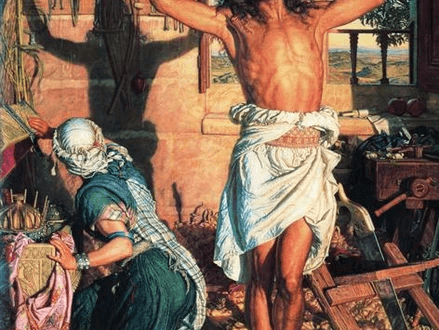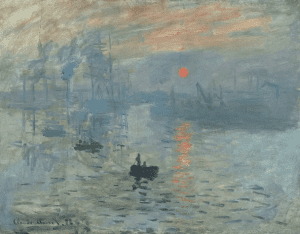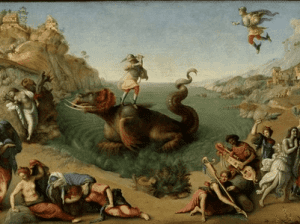Title of Artwork: “The Shadow of Death”

Artwork by William Holman Hunt
Year Created 1873
Summary of The Shadow of Death
During his second visit to the Holy Land in the years between 1870 and 1873, William Holman Hunt worked on a religious painting titled The Shadow of Death. A youthful Jesus, before beginning his mission, is shown here in the trade he would one day master: carpentry. After sawing a piece of wood, he pauses to stretch.
A “shadow of death” foreshadowing the crucifixion is cast by his outstretched arms upon a wooden spar from which building tools dangle. His mother, Mary, is shown staring up at the shadow from behind; she has just finished examining the box in which she has stored the presents she received from the Three Kings.
All About The Shadow of Death
In 1850, John Everett Millais, a contemporary of Hunt’s, depicted Jesus helping his father in the carpentry trade. Critics had pounced on Millais’ picture Christ in the House of his Parents, saying it was tainted by the filth of the artist’s studio. Hunt’s version of the scene is reminiscent of Millais’s, but his focus is on Jesus’ robust health and physique.
The spiritual significance of honest labour was emphasised often by Thomas Carlyle, who may have influenced Hunt’s image of Jesus as a hard-working adult craftsman and labourer.
This coincides with the rise of “Muscular Christianity,” the perspective of authors like Charles Kingsley, Thomas Hughes, and others who advocated for a healthy emphasis on physical fitness and the aggressive pursuit of Christian principles in all aspects of life.
Carlyle had been highly critical of Hunt’s earlier portrayal of Jesus in The Light of the World, labelling it a “papistical” painting since it depicted Jesus in regal robes. Mary’s frugality is portrayed as commendable since she “saves” the gifts she receives in accordance with the emphasis on working class financial responsibility advocated by modern evangelical magazines like The British Workman.
The painting is rich in typological symbolism that alludes to Christ’s place and identity in theology. Connections to Millais’s contemporary Victory O Lord! are possible.
The painting became so well-liked that it was engraved and distributed worldwide. Since the original was sold for a profit, Manchester was able to receive a donation of it in 1883. The City Art Gallery of Manchester now owns it and displays it.
An entry from Francis Kilvert’s diary from 1874, the year after the painting was finished, describes a trip to view it in public. In his journal on June 27, 1874, he wrote, “Unfortunately, I ignored both good advice and sensible caution and saw Holman Hunt’s The Shadow of Death. It cost too much and was not worth it. I regret seeing the film since I found it to be overly dramatic and repugnant.”
Hunt created a miniature of the scene in 1873 as well. “harder and crisper in look than the Manchester picture,” as Hunt scholar Judith Bronkhurst puts it. Its 1994 sale price of £1.8 million was the highest ever for a Pre-Raphaelite painting. Leeds Art Gallery plays host.
Information Citations
En.wikipedia.org, https://en.wikipedia.org/.
Recommend0 recommendationsPublished in Artworks







Responses